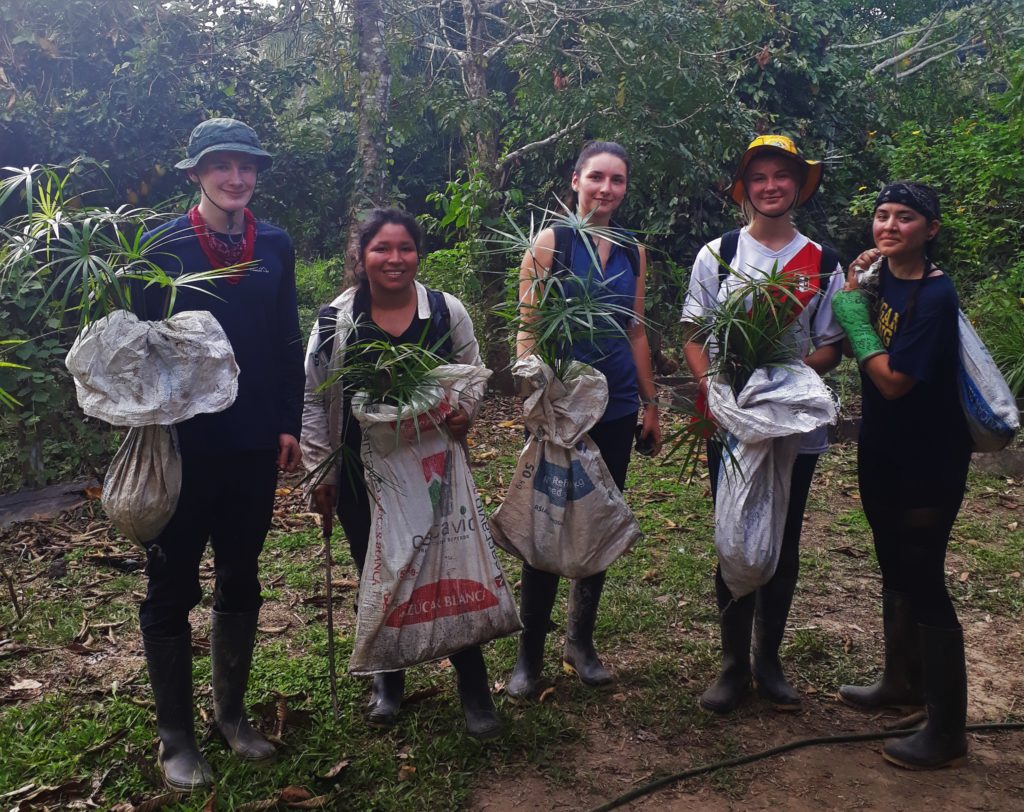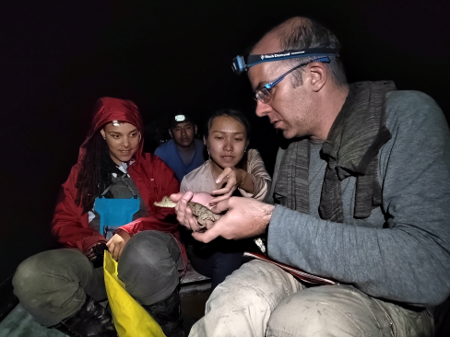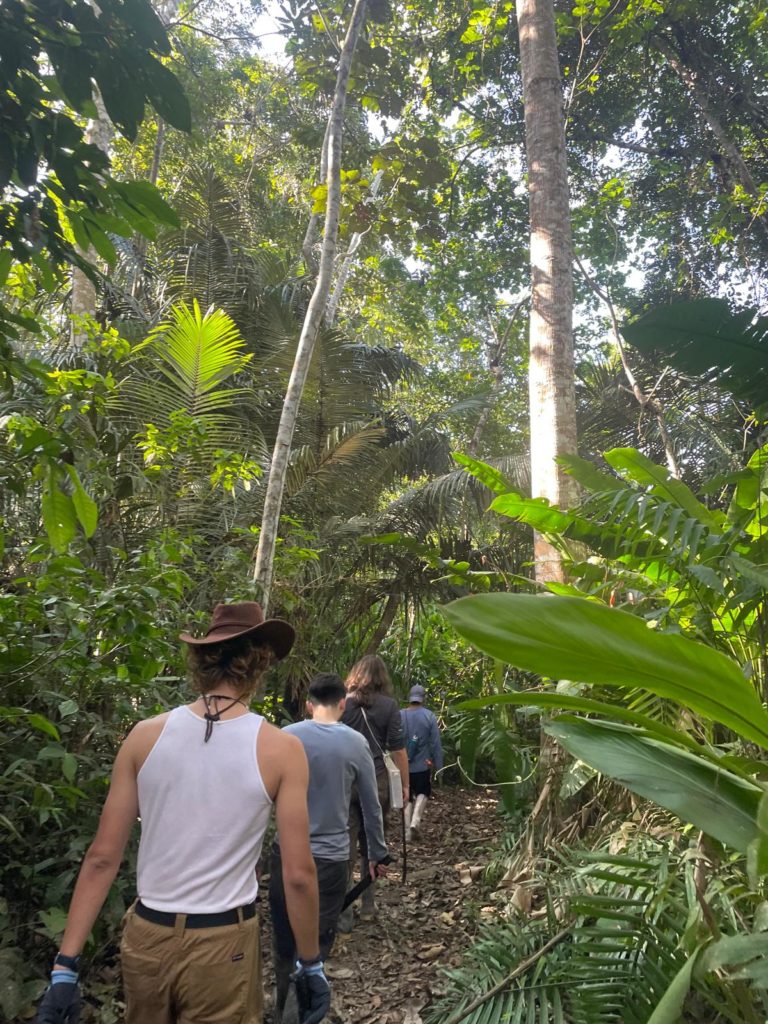
To live and volunteer with us in the Amazonian forest, no particular training is needed. However, your motivation and interest in the environment are essential qualities required. All your skills and abilities will be helpful. Here at the reserve you will have the opportunity to develop both your manual and physical abilities on a daily basis in addition to broadening your intellect, specifically your sense of observation, autonomy and community life.
What Would a Typical Week Look Like?
- Work Week: Sunday–Thursday
- Weekend/Rest Days: Friday & Saturday
- # Activities per Day: 2
- Duration of each Activity: 2-4 hours
*Note: Only 1 activity will be performed per day for activities that take a longer amount of time to complete or are physically demanding (i.e. a long-distance walk, carrying heavy bags filled with plants, transporting composted soil to permaculture sites, etc.)
-

Photographing small birds from observation tower -

Our Activitites are divided into pilars such as
1. Research
2. Education
3. Conservation
3. Maintenance
4. Fun!
Activities can include, but are not limited to, the following:
Research
Mist Netting: Tropical bird catch and release
Activity early in the morning (5:50am) or in the afternoon (2:30pm) where volunteers learn how to use mist nets to capture and release bird species living in the understory of primary and secondary forest. At the beginning of the activity the mist nets are opened and then reviewed every 20-25 min. Experts handle the birds that are captured in the nets while volunteers assist in data collection including identification of species, quality of plumage, sex, location of capture, weight, etc. Volunteers participate in moving and installing nets to new locations on the reserve each month.


Herpetofauna night walk and ID
Night activity where volunteers are guided on a night walk to observe and capture for frogs, lizards and snakes on the reserve. Night walk data includes noting the location and time of capture of herpetofauna. The frogs/lizards/snakes are brought back to camp where they are kept safely overnight. The following day, volunteers learn how to use identification keys specific to the area and take measurements of the herpetofauna. Once data collection is complete the volunteers participate in releasing the herpetofauna in the location they were found the day after they are captured.
Caiman monitoring
Night activity where volunteers collect data on caiman sightings on the Madre de Dios river. Assist us in spotting, catching, and recording data on the 4 species of caiman residing in the area. A caiman is captured for observation so we can record the species, length, location and activity before release.


Mammal monitoring
Activity where volunteers assist in data collection of mammal diversity on the reserve. Evidence of mammal activity such as footprints, scat or other activity is recorded along with date, time, location, direction of travel, and measurements of footprints (Length, width and step).
Trail cams
Activity where volunteers learn the valuable use of trail camera data in research and conservation of species on the reserve. Trail cameras are moved to different locations each month near landmarks known for animal activity such as colpas, swamps, tapir/deer trails. Volunteers have the opportunity to review the trail camera data each month and see the wildlife footage.

Conservation

Reforestation
Our reforestation initiative helps native tree species grow from seeds collected from the reserve. Volunteers assist in planting native tree species from the tree nursery on transects on Panthera Sanctuary. Transects are composed of a variety of tree species where volunteers record the location, diameter and height of the saplings.
Mammal Corridor
Monthly activity where volunteers encourage mammals to use the reserve and protected land as part of their territory. Fruit is placed on platforms in the canopy and at especially active areas such as clay licks, swaps and trails for the mammals and birds to forage. The activity is carried out only occasionally to prevent animals from becoming dependent on human intervention.


Habitat Enhancement
Activities that help improve habitat and encourage wildlife to thrive on the reserve. Some examples include reactivating collpas, digging mammal wells, creating snake nests, bat boxes and more!
Education
Forest Introduction
Orientation activity for new volunteers where volunteers are lead by a guide to learn about the Peruvian amazon and Panthera Sanctuary.


Fruit Collection
Work in the agroforest to learn about the various fruits that grow on the reserve. Volunteers assist in harvesting fruits such as bananas, plantains, lemons, mandarin oranges, starfruit, cocao, etc. Fruits can be made into jam, juice, or dried for preservation. Lemongrass and roots such as ginger and turmeric are used for tea or other healthy infusions. Veggies and other herbs collected are incorporated into our local dishes!
Permaculture and Greenhouse work
Participate in sustainable growth of food on the reserve. Tending to our fruit/vegetable garden by weeding, watering, planting seeds and replenishing plot with fertile soil. Plant seeds from native trees on the reserve for the reforestation initiative. Seeds are collected in the forest and planted in nursery bags to germinate in the greenhouse.


Botany
Guides take volunteers on a nature walk to learn about the flora on the reserve. Volunteers learn botanical vocabulary, forest ecology and how to identify certain plants.
Bird watching
guides take volunteers on bird watching tours on the reserve. Field guides and binoculars are used to better admire, locate and identify the bird diversity on the reserve. Volunteers can visit the bird tower to watch bird activity overlooking the swamp and forest.
.


Forest patrol
Volunteers help monitor the reserve and prevent illegal logging and poaching on the land.
Survival skills
Learn how to orient yourself, first aid techniques, basic knots, safe water and food collection, and learn to build a shelter.

Maintenance

Trail cleaning
Help maintain the various trails throughout the reserve. Locating closed off or narrow reserve trails and removing any dangerous obstacles to keep paths safe and navigable. Volunteers may help assist in updating the trail markers on the Panthera trails.
Maintenance of buildings and structures
Help keep the reserve running, volunteers assist in the maintenance of the buildings and structures found on the reserve. Maintenance activities may include general cleaning, roof fixing, caring for the bird tower, maintenance of plumbing and boats.

Fun

Fishing
Volunteers are guided for an afternoon of fishing on the Madre de Dios river.
Beach
When the river is low, volunteers are taken to the beach at the end of the week to swim, play volleyball, play futbol, and enjoy the scenery on the Madre de Dios River.

Activities you want to know more about that aren’t on the list? Check out our current Projects or contact us with your inquiries!
